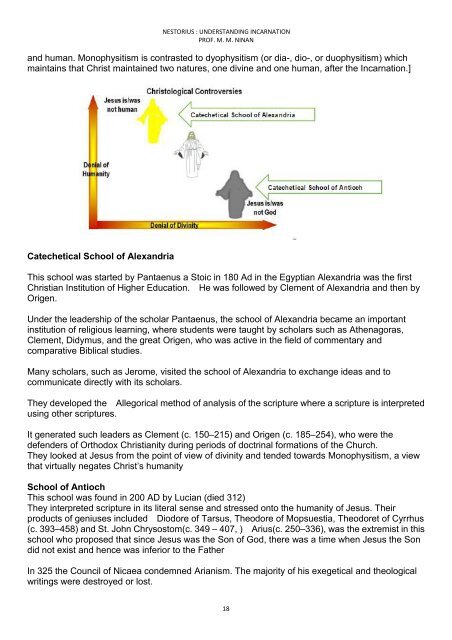Nestorius
You also want an ePaper? Increase the reach of your titles
YUMPU automatically turns print PDFs into web optimized ePapers that Google loves.
NESTORIUS : UNDERSTANDING INCARNATION<br />
PROF. M. M. NINAN<br />
and human. Monophysitism is contrasted to dyophysitism (or dia-, dio-, or duophysitism) which<br />
maintains that Christ maintained two natures, one divine and one human, after the Incarnation.]<br />
Catechetical School of Alexandria<br />
This school was started by Pantaenus a Stoic in 180 Ad in the Egyptian Alexandria was the first<br />
Christian Institution of Higher Education. He was followed by Clement of Alexandria and then by<br />
Origen.<br />
Under the leadership of the scholar Pantaenus, the school of Alexandria became an important<br />
institution of religious learning, where students were taught by scholars such as Athenagoras,<br />
Clement, Didymus, and the great Origen, who was active in the field of commentary and<br />
comparative Biblical studies.<br />
Many scholars, such as Jerome, visited the school of Alexandria to exchange ideas and to<br />
communicate directly with its scholars.<br />
They developed the Allegorical method of analysis of the scripture where a scripture is interpreted<br />
using other scriptures.<br />
It generated such leaders as Clement (c. 150–215) and Origen (c. 185–254), who were the<br />
defenders of Orthodox Christianity during periods of doctrinal formations of the Church.<br />
They looked at Jesus from the point of view of divinity and tended towards Monophysitism, a view<br />
that virtually negates Christ’s humanity<br />
School of Antioch<br />
This school was found in 200 AD by Lucian (died 312)<br />
They interpreted scripture in its literal sense and stressed onto the humanity of Jesus. Their<br />
products of geniuses included Diodore of Tarsus, Theodore of Mopsuestia, Theodoret of Cyrrhus<br />
(c. 393–458) and St. John Chrysostom(c. 349 – 407, ) Arius(c. 250–336), was the extremist in this<br />
school who proposed that since Jesus was the Son of God, there was a time when Jesus the Son<br />
did not exist and hence was inferior to the Father<br />
In 325 the Council of Nicaea condemned Arianism. The majority of his exegetical and theological<br />
writings were destroyed or lost.<br />
18

















